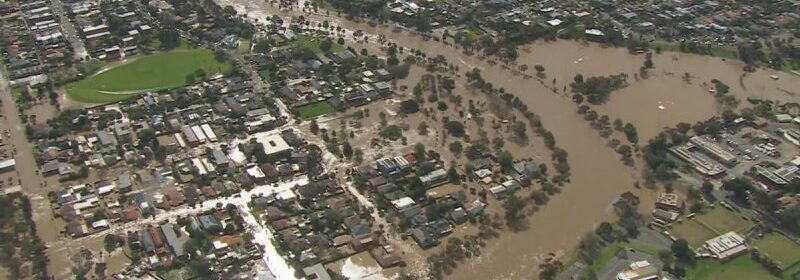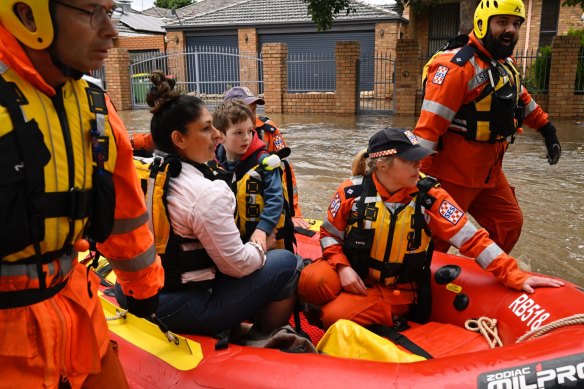Small hope from Maribyrnong flood inquiry submissions

Save articles for later
Add articles to your saved list and come back to them any time.
Melbourne Water’s inquiry into the Maribyrnong River floods has a long way to go, but residents whose homes were inundated last October initially may feel doubtful that they will get the answers and reassurances they are seeking with submissions to the review released yesterday.
The scope of the inquiry, which is an independent review run by Melbourne Water, has been criticised since its inception six months ago as too narrow to deliver assurances for householders and owners of other properties that authorities will learn from the devastation of last year’s event to ensure it never happens again.
Nancy Franics and her son Lawrence rescued in the Esplande in MaribyrnongCredit: Chris Hopkins
In the worst flooding in 48 years and the third-largest since records began in the late 1800s, the fast-flowing muddy waters of the Maribyrnong inundated more than 600 properties on the morning of October 14, 2022. The recovery measures in Melbourne’s inner north-west continue, and many residents are yet to return to their homes.
The inquiry is looking into what caused and contributed to the flooding, including whether the controversial Flemington Racecourse wall — a 2.5-metre-high, two-kilometre-long embankment wall built by the Victorian Racing Club in 2007 to protect its venue if the Maribyrnong burst its banks — affected the extent and duration of the event. The inquiry’s review panel will make its findings and recommendations to the state government in September.
But for many residents, the inquiry is viewed as a waste of time because it will not examine failures of the warning and evacuation procedures and the emergency response that left them to wake on the morning of October 14 to the shock discovery of floodwaters entering their homes. Those matters have been placed outside the scope of the review, along with an examination of potential mitigation measures such as additional floodwalls, levees or dams. Government policy responses are also excluded from the term of reference.
In Melbourne Water’s submission to the inquiry, made public yesterday, the government-owned body admitted no mistakes and shifted blame for its failure to adequately warn residents of the impending disaster to the Bureau of Meteorology and its rainfall forecasts.
It says a rainfall forecast that was revised down led to Melbourne Water downgrading its flood prediction to “moderate” at 2.24pm on October 13. “Around 12.30am on October 14,” the submission says, “Melbourne Water identified that the real-time data showed the river was rising faster than the model had predicted. Melbourne Water updated its predictions.”
Melbourne Water prepared and sent a flood warning to the bureau at 2.27am that was upgraded to “major”. Emergency text messages sent at 4.30am and 6.30am gave residents little time to evacuate or prepare for the floodwaters to enter their homes.
Melbourne Water noted that it is “one of several agencies that have a role to play in responding to flood events”. Of the 62 submissions the inquiry received before its March 17 cut-off, none were from the Bureau of Meteorology.
To Melbourne Water’s credit its submission includes a commitment to upgrade its decades-old Maribyrnong River flood modelling after it failed to adequately predict the scale of the deluge that would hit hundreds of homes until it was too late.
Local councils, the cities of Maribyrnong and Moonee Valley, both used their submissions to condemn the scope of the inquiry and to push for the expansion of the terms to reference to take in the matter specifically excluded.
The councils, whose planning decisions around flood risk are guided by advice from Melbourne Water, have called for an improvement to modelling methodology that also takes into account forecasts of more extreme weather events brought on by the impact of climate change.
Their calls for greater scrutiny of planning measures and the potential extension of overlays to avoid building development in flood-prone areas are sensible, as are their calls for measures that improve community awareness when purchasing properties in these areas. Consideration of compensation measures for residents affected by new overlays is also raised.
The inquiry and the subsequent response of the state government must ensure that actions are taken to provide comfort and security to those who live in areas where historic flooding has occurred, especially as climate change heightens such threats.
To that end, the councils have made separate but similar recommendations in their submissions that the state take its lead from its response to bushfire disasters by providing greater community education about impact and dangers of flood events.
The review has been described by the Greens as a smokescreen designed to avoid political scrutiny, and The Age has argued that its narrow scope is greatly to its detriment.
But among the disappointment of Melbourne Water’s response, there were submissions from key parties yesterday that give the review some hope of a more secure future for the many residents who are drawn to the beauty of the Maribyrnong River.
Patrick Elligett sends an exclusive newsletter to subscribers each week. Sign up to receive his Note from the Editor.
Most Viewed in National
From our partners
Source: Read Full Article
